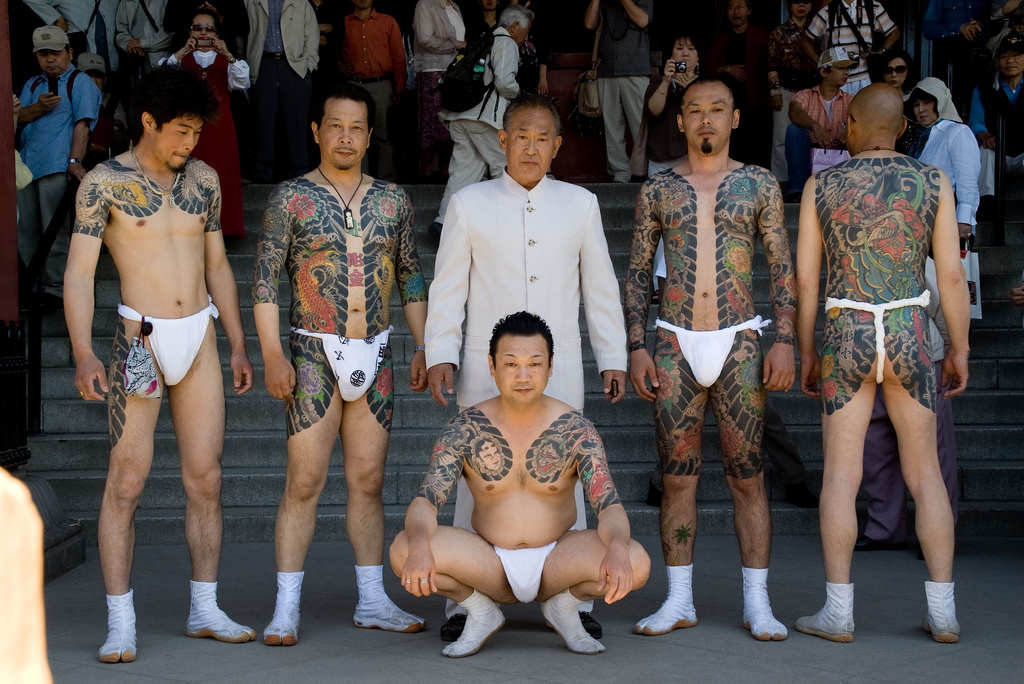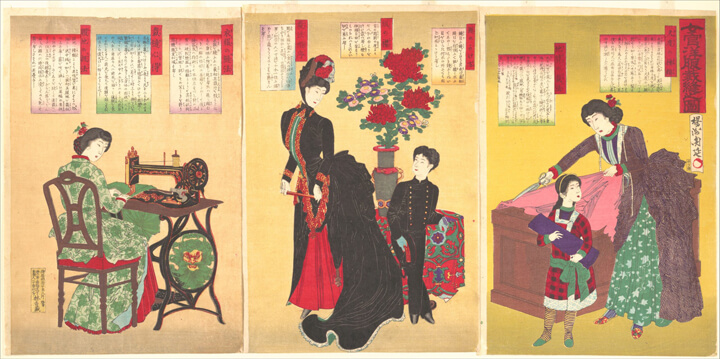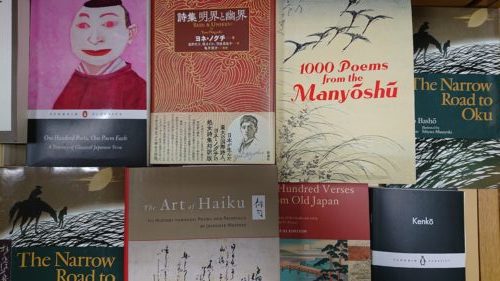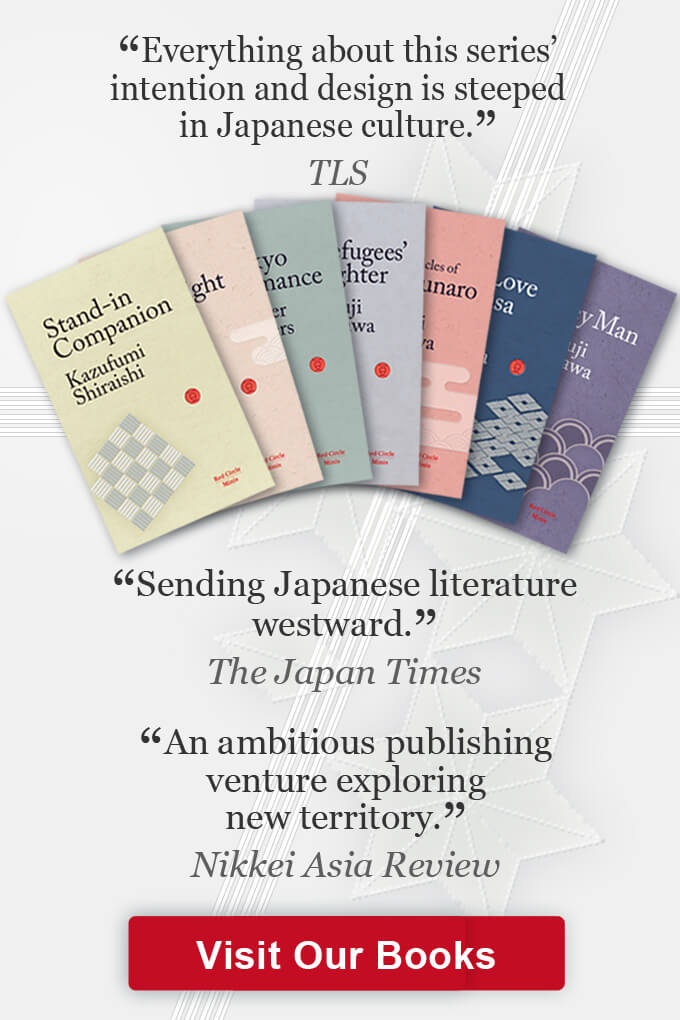 Color and pattern printed on a kimono Photo: musumemiyuki (Wikimedia)
Color and pattern printed on a kimono Photo: musumemiyuki (Wikimedia)Japanese has a special alphabet for foreign words: katakana, which has helped it manage the impact of foreign words entering its language. In addition, romaji (Roman script) employs the ‘Latin script’ that Western European languages use to help those in Japan who can’t read the other alphabets. It is also sometimes used for product names and in clever marketing copy.
Despite this, the massive influx of loaned or borrowed words in Japanese is still making life difficult for some. A 72-year-old man has gone to the extreme of taking Japan’s national broadcaster NHK to court over its over use of foreign words. He didn’t win the case. The shisutemu (system) – one of the words he complained about – got the better of him on this occasion. Nevertheless, few Japanese people are aware of the impact their language is now having around the world.
Few English speakers know either. But Japanese words are seeping into the linguistic zeitgeist. Unbeknownst to many, words such as honcho, as in head honcho, are in fact Japanese. Hancho (group or squad leader), was imported to the United States by servicemen stationed in Japan in the 1940s as honcho and the word rickshaw, which tourists still enjoy riding in many capital cities, is a late 19th-century abbreviation of the Japanese word jinrikisha, meaning man-powered vehicle. Another such word is tycoon, which comes from the Japanese word taikun, great prince or high commander.
New arrivals in Japan enjoy commenting on the sometimes eye-catching product names written in romaji such as: Collon (a creamy snack); Calpis (a soft drink); Pocari Sweat (another sports drink) and Creap (instant powdered milk).
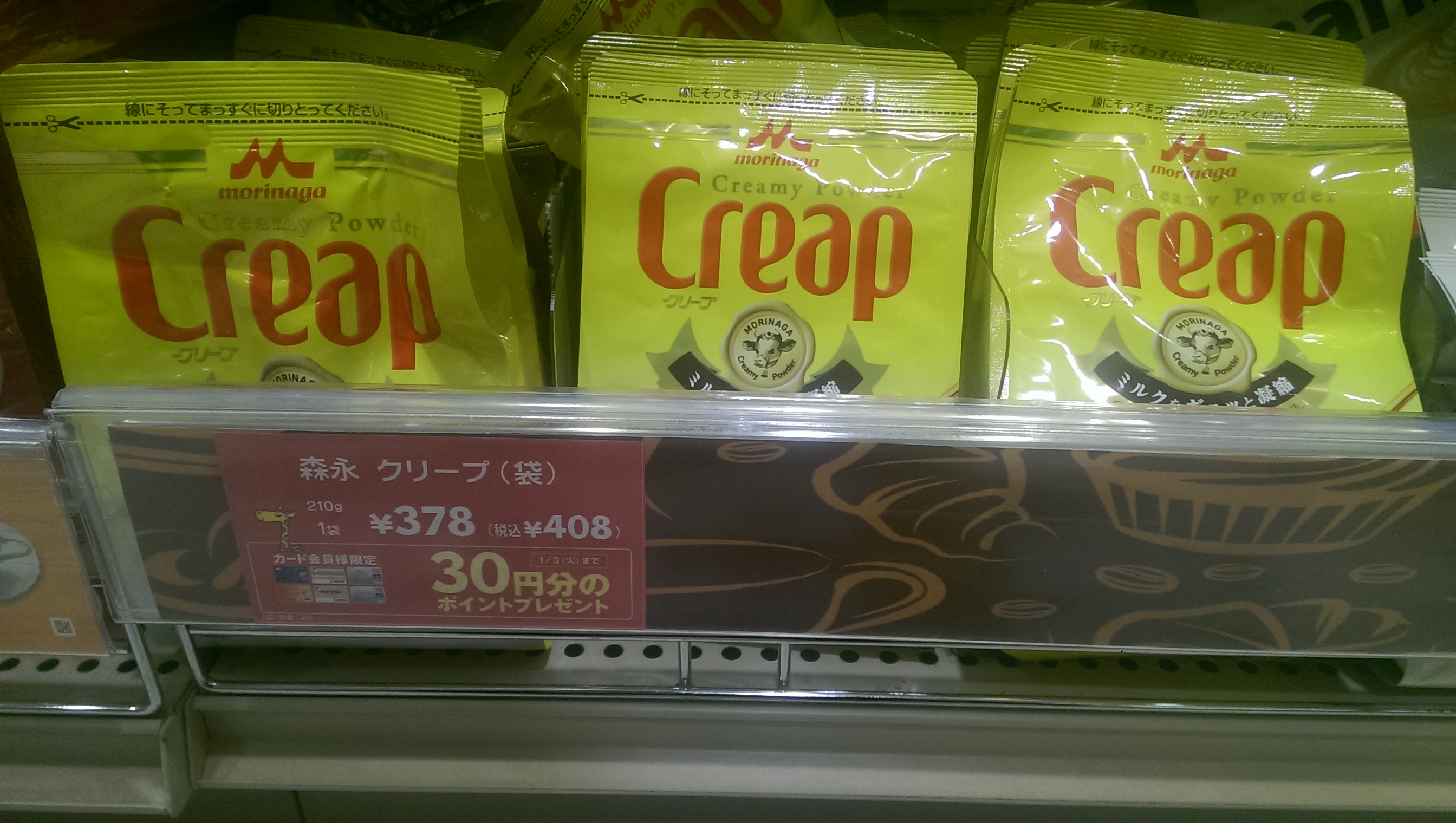 A Japanese brand of powdered milk that like its western equivalent will transform “your everyday coffee into something quite extraordinary.” Photograph: Red Circle Authors Limited.
A Japanese brand of powdered milk that like its western equivalent will transform “your everyday coffee into something quite extraordinary.” Photograph: Red Circle Authors Limited.The interesting and unusual use of foreign words outside their country of origin is not, however, limited to English in Japan.
The provenance of some Japanese-based English expressions such as: To Open the Kimono is obscure. This phrase, for example, is popular within the world of IT, especially in North America, and generally means to share information or reveal the inner workings of a project or company. Steve Jobs, the founder of Apple, famously used the expression in 1979 during a visit to Xerox Parc when he is reported to have said: “Look, I will let you invest a million dollars in Apple if you will sort of open the kimono on Xerox Parc”. This memorable expression and meeting apparently led to him discovering the mouse, and Apple subsequently launching the first commercial mouse: and the rest is history, as they say.
One of the best-known Japanese words, alongside sushi and samurai, outside Japan, however, is probably sayonara. It is now technically an English word and is often used to mean a final farewell not just a simple goodbye. In the 1950s, when the United States was re-evaluating its post-war relationship with Japan, in light of the Korean War and its desire to halt the spread of communism, a cluster of Hollywood films were set in Japan including one starring Marlon Brando titled Sayonara, based on the book by James A. Michener.
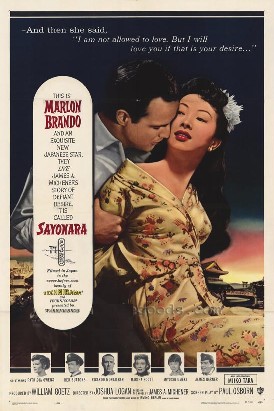 Film poster of the Warner Brothers distributed film about a pilot stationed at an air base near Kobe during the Korean War. Image Credit: Wikipedia.
Film poster of the Warner Brothers distributed film about a pilot stationed at an air base near Kobe during the Korean War. Image Credit: Wikipedia.The film was a huge success and received excellent reviews and won four Academy Awards. It was said to have promoted racial tolerance and was the most successful of this genre, which included others with titles like: The Tea House of the August Moon and Japanese War Brides. The world became familiar with the word sayonara: and Japan with Marlon Brando. So much so that the famous all-women theatre troupe Takarazuka are said to have modeled the movements, poses and gestures of the men in their shows (performed by women) on the perfect male – Marlon Brando. George Chakiris, best known for his role as Bernardo in the film version of West Side Story, and Alain Delon, like Brando, have also been mimicked in their musicals and extravaganzas.
Many Japanese words have followed Japanese inventions, foods, products, management techniques, activities and sports that have been embraced or copied internationally. For example, karaoke, futon, wasabi, tofu, bento, kaizen, bonsai, koi, manga, anime, origami, judo, aikido, karate, emoji and tsunami to list just a few.
In fact, the rate of adoption has shot up, and even the Oxford English Dictionary, which regularly publishes a list of new words that have entered into its dictionary, has noticed and commented on this. Three examples include such words as: otaku meaning a young person who is obsessed with computers or particular aspects of popular culture to the detriment of other social skills, which officially became English in 2004 when it joined the other eight hundred thousand words in the Oxford English Dictionary. Hikikomori meaning the abnormal avoidance of social contact entered the dictionary in 2010; and matcha, the powdered green tea leaves, dissolved in hot water to make tea or used as a flavouring, entered in 2015.
The Internet and its associated memes are accelerating interaction and the exchange of language and culture; even if it is something as trivial as the recent Pen Apple Pineapple Pen (PPAP) craze from Japan. All of which increases the number of loanwords in use. This is keeping the world’s lexicographers busy.
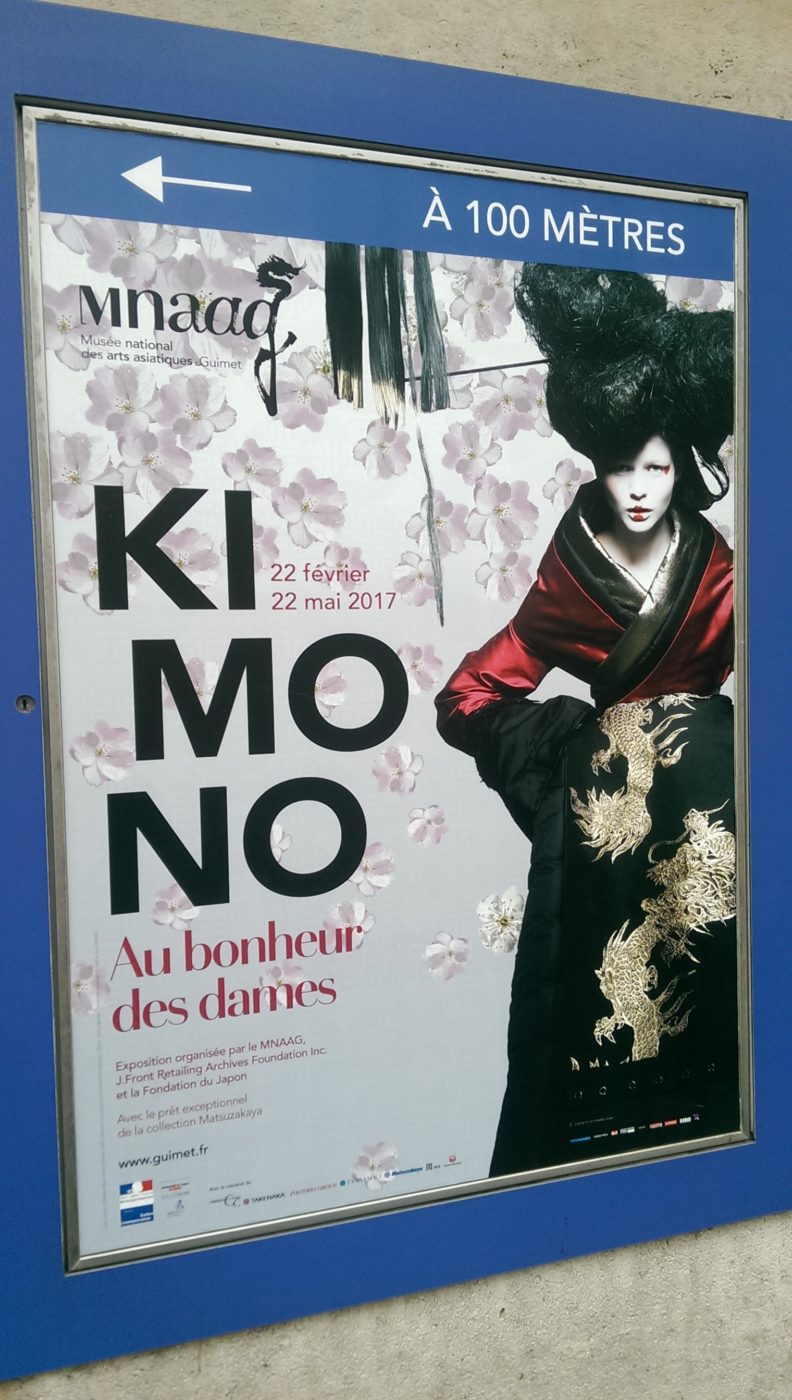 The kimono is shaped like a T and unlike Western clothes is unrelated to the curves of the body. The traditional garment found its definitive form around the 10th century. The word kimono, its shape and structure as well as the different fabrics used in their design have had international impact and influenced leading international designers, such as Yves Saint Laurent, Jean Paul Gaultier and Franck Sorbier and French Haute Couture in particular. Photograph: 2017 poster for The Kimono exhibition at the Guimet Museum Paris. Red Circle Authors Limited.
The kimono is shaped like a T and unlike Western clothes is unrelated to the curves of the body. The traditional garment found its definitive form around the 10th century. The word kimono, its shape and structure as well as the different fabrics used in their design have had international impact and influenced leading international designers, such as Yves Saint Laurent, Jean Paul Gaultier and Franck Sorbier and French Haute Couture in particular. Photograph: 2017 poster for The Kimono exhibition at the Guimet Museum Paris. Red Circle Authors Limited.This, however, isn’t just a phenomenon in the English-speaking world. It is a global trend. It is happening even in France, which has its famous Academie Francaise, founded in the 1630s, that tries so hard to protect French from words such as Le Weekend and anglicization in general. The Japanese language, like its food and sushi in particular, is having a lasting impact on the country. When a mass-market French action-comedy film is launched with the title Wasabi it inevitably works its way into the language, even if the film receives mixed reviews.
Japan has a love of modification and simplifying which extends to language. It invents new words for its products that sometimes end up defining new categories such as the Walkman did in the 1980s and karaoke, which spread across Asia in the 1990s and is now said to be a 10 billion dollar industry. There are many examples of loanwords being re-exported with a distinct Japanese flavour. Words like animation as anime or costume play as cosplay, both of which now define new popular-culture categories.
In 2011, China overtook Japan to become the world’s second largest economy. This was a wake-up call for many in Japan, but Japan is still far ahead of China in terms of the number of words that are borrowed from its language.
This isn’t the type of export that the Japanese government is targeting or that the World Economic Forum (WEF) measures as part of its Global Competitive Index. And no doubt Japan is running a trade deficit with the English-speaking world in terms of loanwords. But if vocabulary is one factor within Soft-Power, Japan is streaks ahead of China on this measure.
Experts and commentators generally give three reasons for this: Japan’s economy has been open for longer; Japanese uses romaji and katakana which makes its language more flexible; and thirdly the sounds used in Chinese are much harder to pronounce for non-Chinese people than is the case with Japanese.
If you were to consider language or each single word as a product you would also look at this trend within the framework of best practice for localising product names. Three important factors are often cited by branding and naming experts: a phonologically simple and pronounceable name; one that’s easy to read for non-native speakers; and one that’s adaptable to syntax. All of which would seem to apply more naturally to Japanese than Chinese.
The export of Japanese words – original or reinvented loanwords – into the languages of the world is hard to count, but is a growing Japanese success story and reflects the increasing interest in Japan and all things Japanese.
Sentences and ideas follow words and if as the American philosopher Daniel C. Dennett says: “words are memes that can be pronounced” then surely it is just a matter of time before works by the talented wordsmiths of Japan will follow its vocabulary, become familiar, and part of our regular and recommended reading lists no matter where we live or what language we speak or read – or the type of device we read on.
 Slogan from the English PEN, an international writers association, stand at the 2017 London International Book Fair (LBIF). English PEN campaigns for The Freedom to Write and the Freedom to Read. Photograph: Red Circle Authors Limited.
Slogan from the English PEN, an international writers association, stand at the 2017 London International Book Fair (LBIF). English PEN campaigns for The Freedom to Write and the Freedom to Read. Photograph: Red Circle Authors Limited.
